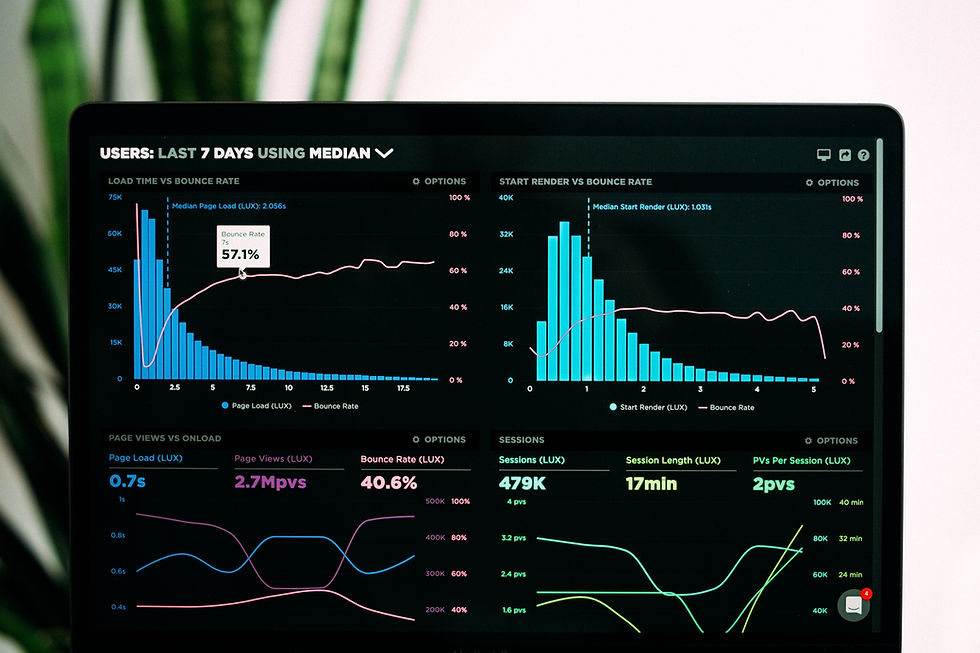Developing Marketing Dashboard Step by Step
- Hooman Hashemi

- Jan 2, 2024
- 4 min read
Keeping track of various metrics and performance indicators is crucial for making informed decisions. A well-crafted marketing dashboard can serve as a compass, guiding your organization towards success by providing a consolidated view of key performance indicators (KPIs) and integrating data from diverse sources.
In this guide, I'll dive into a step-by-step process of developing a meaningful marketing dashboard and explore the applicability of the agile methodology. Developing a Meaningful Marketing Dashboard Step by Step

1. Understanding the Audience Developing a Marketing Dashboard
The first step in creating an effective marketing dashboard is to determine your audience. Different stakeholders within your organization will have distinct needs and expectations. Executives may require a high-level overview of ROI and budget allocation, while social media marketers might need detailed insights from platforms like Twitter, Facebook, Google+, and LinkedIn. Tailoring your dashboard to address the specific needs of each audience ensures that it tells a compelling story relevant to their decision-making process.
2. Defining Stakeholder Objectives
Aligning with the objectives of your stakeholders is crucial for the success of your marketing dashboard. Establish both short-term and long-term goals and build different views of data at varying levels of granularity. For example, an executive might focus on overall return on investment, while an analyst might need a detailed view for tactical decision-making. By understanding stakeholder objectives, you can create a dashboard that not only visualizes data but also provides actionable insights and a clear path for immediate action.
3. Identifying Key Performance Indicators (KPIs)
Determining the right KPIs is the backbone of any effective marketing dashboard. These metrics should align with your specific marketing strategy and goals. KPIs can range from social media engagement metrics like likes and clicks to business impact metrics such as conversions, brand value increase, or sales growth. Tailor your analytics dashboard to the personalized KPIs of each marketing campaign, avoiding a one-size-fits-all approach. This ensures that the metrics tracked are relevant to the unique objectives of each campaign.
4. Selecting Data Sources and Ensuring a Unified View
In the digital marketing landscape, numerous tools generate data, from multi-channel campaigns and intent data to twitter followers and web metrics. It's essential to identify and consolidate these diverse data sources into a single platform. However, avoid falling into the trap of information overload. Choose the metrics that truly matter and select data sources that contribute to the defined KPIs. A unified view ensures that your marketing dashboard provides a comprehensive and cohesive representation of your overall marketing performance.
5. Visualizing Data for Enhanced Understanding
Marketing analytics tools generate vast amounts of data, and how you present this data is crucial. Visualization tools play a significant role in conveying the right message and facilitating data discovery and analysis. Ensure that your marketing team can easily create and consume visualized data to uncover insights that might be overlooked in raw data formats. Visualization adds value by making data more understandable, leading to better decision-making and strategic planning.
6. Data Integration for a Holistic View
Today's marketing teams use a multitude of tools, each with its own set of metrics. A key objective of any analytics dashboard is to integrate this data into a consistent view. Utilize visualization tools that can weave together multiple data sources into a single, coherent narrative connected to outcomes and return on investment. Without proper data integration, you risk missing out on valuable insights and a holistic understanding of your marketing performance.

Agile Methodology in Marketing Dashboard Development
The agile methodology, known for its iterative and collaborative approach, can be highly applicable in the development of marketing dashboards. Agile principles emphasize flexibility, adaptability, and customer feedback, aligning with the dynamic nature of digital marketing. Breaking down the development process into smaller, manageable iterations allows for continuous improvement based on evolving requirements and emerging tools.
Benefits of Agile Methodology in Marketing Dashboard Development:
Flexibility to Adapt to Changes: The digital marketing landscape is constantly evolving, with new tools and trends emerging regularly. Agile allows for quick adaptation to changes in data sources, KPIs, or stakeholder objectives.
Iterative Development: Developing a Minimum Viable Product (MVP) or beta version of the marketing dashboard allows for rapid testing and feedback. This iterative approach ensures that each version brings incremental improvements, leading to a more refined final product.
Collaboration and Communication: Agile promotes regular collaboration between cross-functional teams, fostering open communication and a shared understanding of project goals. This is crucial in the development of a tool that caters to the diverse needs of different stakeholders.
Customer-Centric Development: By involving stakeholders and end-users throughout the development process, agile ensures that the marketing dashboard aligns with their expectations and provides meaningful insights. Regular feedback loops contribute to a customer-centric approach.
Developing the MVP or Beta Version:
The concept of the Minimum Viable Product (MVP) or beta version is instrumental in the agile methodology. In the context of a marketing dashboard, the MVP serves as an initial version that includes essential features and functionalities. This version is released to a select group of users or stakeholders for testing and feedback.
Gathering Feedback: The MVP allows for real-world testing, enabling users to interact with the dashboard and provide valuable feedback. This feedback is crucial for identifying usability issues, refining features, and ensuring that the final product meets user expectations.
Iterative Improvements: Based on the feedback received, iterative improvements are made to the dashboard. This iterative process continues, with each version addressing specific concerns or introducing new features. The goal is to enhance usability, address pain points, and deliver a more meaningful and valuable final product.
Managing Expectations: Introducing the concept of an MVP helps manage expectations. Stakeholders understand that the initial version is a work in progress, and their input is essential for shaping the final outcome. This transparency fosters a collaborative environment and ensures that the end product aligns with user needs.
Finally
Developing a meaningful marketing dashboard is a strategic endeavor that requires careful planning, understanding of stakeholder needs, and adaptability to the dynamic nature of digital marketing. By following the steps outlined in this guide and incorporating agile principles, you can create a dashboard that not only meets the unique requirements of your organization but also evolves over time to stay relevant in the ever-changing landscape of digital marketing.
Remember, the journey towards a meaningful marketing dashboard is not a one-time effort but a continuous process of refinement and adaptation. Embrace feedback, stay informed about emerging tools and trends, and let your marketing dashboard be a dynamic tool that empowers your organization to make informed decisions and drive success in the competitive digital landscape.


